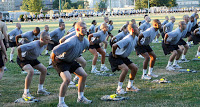Changes
in KOOS and WOMAC Scores in a Young Athletic Populations With and Without
Anterior Cruciate Ligament Injury
Antosh
I, Svoboda SJ, Peck KY, Garcia EG, & Cameron KL. Am J Sports Med. 2018; 46(7): 1606-1616. DOI: 10.1177/0363546518768753
service academy with an anterior cruciate ligament (ACL) reconstruction tend to
report poorer patient-reported outcomes at 2 years post reconstruction than
healthy uninjured peers.
Most patients after an anterior
cruciate ligament (ACL) reconstruction experience a near-full recovery of
functional outcomes. However, many of these patients fail to return to
preinjury activity levels and report lingering knee symptoms. It is challenging to interpret these
lingering symptoms without knowing how patients were doing prior to injury. Hence, these authors conducted a prospective
study to compare patient-reported outcomes between students at a US service
academy with and without an ACL injury.
Researchers assessed patient-reported outcomes of all incoming cadets with
the Knee Osteoarthritis Outcome Score (KOOS), the Western Ontario and McMaster Universities Osteoarthritis Index (WOMAC), and Marx Physical Activity Rating Scale (MARS). Through the four-year study period, 30 students
out of ~1000 students with no previous injury suffered an ACL injury (without
multi-ligamentous injury requiring surgical care) and were enrolled in the
study for a 2-year follow-up period.
Three healthy controls were matched to every 1 participant with an ACL
injury by age, sex, and activity level.
Follow-up assessments were completed in the ACL group prior to surgical
reconstruction, and then again after surgery, 6 months, 1 year, and 2 years
post-surgery. Healthy controls were contacted and re-assessed within 1 year of
graduation – about 4 years after their baseline assessments. Patient-reported outcomes were comparable at
preinjury assessment. However, 2 years after an ACL injury students reported
worse knee pain, symptoms, quality of life, sports function, and stiffness than
their peers. These differences met the criteria for being clinically meaningful. Compared to pre-injury scores, the students
with an ACL injury tended to report meaningful worsening in knee symptoms,
sports function, quality of life, and activity levels at 2 years after an
injury. In contrast, the healthy uninjured students showed similar
patient-reported outcomes between entering the academy and after graduation.
prospectively demonstrate differences in patient-reported outcomes between students
with and without an ACL injury. This is
very interesting because it is in a relatively homogenous group of military
cadets who are experiencing similar physical activity demands. This helps us infer
that the ACL injury is likely the cause of these deficits. ACL injured participants showed improvements
in patient-reported outcomes post-surgery, but these improvements plateaued and
failed to return to their pre-injury levels. These poor patient-reported
outcomes may be part of the reason that we are seeing the general population
fail to return to preinjury levels of activity. More informatively, in this
military cohort, we are seeing that their physical activity levels are
remaining relatively consistent with healthy controls despite poorer patient-reported
outcomes. It would be interesting to see if and how the patient-reported
outcomes change over the next few years and how this influences their ability
to remain in active service. In the
meantime, this is another reminder to clinicians that it may be valuable to
assess patient-reported outcomes over time after an ACL reconstruction to get a
better sense of the patient’s symptoms and how they perceive their function.
patient-reported outcomes do you currently use after ACL injury? Are there any other factors that you think
would be valuable to include in trying to assess long-term joint health?
by: Nicole
Cattano
by: Jeffrey Driban
Posts:


